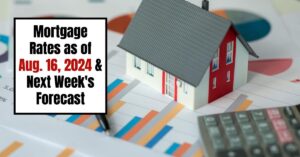In a stunning revelation, nearly 90% of metro areas registered home price gains in the second quarter of 2024, according to the latest report from the National Association of REALTORS® (NAR). This surge reflects a significant trend in the housing market, highlighting how the dynamics of home buying and selling continue to evolve despite economic fluctuations. Let's explore what factors have contributed to these gains, the implications for homebuyers and sellers, and the overall trajectory of the housing market.
Nearly 90% of Metro Areas Registered Home Price Gains in Second Quarter of 2024
A Record-Breaking Quarter
The data shows that 199 out of 223 tracked metro markets experienced price increases, accounting for an impressive 89% of the areas surveyed. The NAR's findings underscore the resilience of the housing market amidst varying economic challenges. The 30-year fixed mortgage rates, fluctuating between 6.82% to 7.22%, have played a role in shaping buyer behavior during this period.
NAR Chief Economist Lawrence Yun notes, “The record-high home prices in most metro markets bring good and bad news.” While it is fantastic news for homeowners who have seen their wealth increase, it poses a significant challenge for potential buyers seeking affordability in a market where the required income to qualify for a mortgage has roughly doubled over the past few years.
Key Insights from the Report
- Overall, the national median single-family existing-home price rose to $422,100, a 4.9% increase compared to last year. This reflects a continual appreciation trend which is vital in assessing market health.
- The South continued to be a powerhouse in real estate, accounting for 45.5% of single-family existing homes sold in Q2, with a 2.3% year-over-year price appreciation.
- Other regions showed noticeable gains, including:
- Northeast: 9.8%
- Midwest: 5.5%
- West: 5.4%
Metro Areas with the Most Significant Price Gains
An intriguing aspect of the NAR report is the identification of the top 10 metro areas that recorded the largest year-over-year median price increases, each exhibiting gains of at least 14.1%. Notably, the top performers included:
- Racine, WI: 19.8%
- Glens Falls, NY: 19.8%
- El Paso, TX: 19.2%
- Morristown, TN: 16.7%
- Manchester-Nashua, NH: 16.2%
Five of these cities are located in the Northeast, showcasing that while some areas in the South are thriving, the Northeast continues to have competitive markets as well.
The Most Expensive Markets
The report revealed that seven of the top ten most expensive markets in the U.S. are located in California. The ranking is as follows:
- San Jose, CA: $2,008,000 (11.6% increase)
- San Francisco, CA: $1,449,000 (8.5% increase)
- Anaheim, CA: $1,437,500 (15% increase)
- Urban Honolulu, HI: $1,101,500 (3.8% increase)
- San Diego, CA: $1,050,000 (11.4% increase)
The sheer numbers demonstrate the ongoing challenges for those looking to enter these markets, particularly first-time homebuyers who may be priced out.
Challenges for First-Time Buyers
The report indicates a worsening trend of housing affordability as mortgage rates have risen. The monthly mortgage payment on a typical existing single-family home with a 20% down payment reached $2,262, marking an 11.1% increase from the previous quarter, and 10.3% higher than one year ago.
Additional highlights concerning first-time buyers include:
- A typical starter home now valued at $358,800 incurs a monthly payment of $2,218, a stark increase of 11.1% from the prior quarter.
- First-time buyers are now allocating about 40% of their family's income to mortgage payments, up from 36.5% previously.
This situation creates a challenging environment for many would-be homeowners trying to navigate through limited inventory and escalating prices.
Declining Markets
Interestingly, not every metro area is witnessing price gains. Approximately 10% of markets (22 of 223) observed declines in home prices during the second quarter, up from 7% in the first quarter. Markets that had previously seen rapid gains, such as Nashville, Durham, and Austin, have cooled off, while others that experienced price decreases last year, including San Francisco and New York, have begun to show signs of recovery.
Looking Ahead: Future Market Predictions
Yun remains optimistic about the housing market's future, stating, “Housing affordability will improve in upcoming months.” This projection hinges on the expectation of a decrease in mortgage rates, coupled with an influx of homes entering the market, which could ease the financial strain on potential buyers.
Conclusion
In summary, the housing market in the U.S. during the second quarter of 2024 has demonstrated remarkable resilience, with nearly 90% of metro areas registering price gains. While this may be good news for current homeowners, the implications for prospective buyers highlight the ongoing affordability crisis. As we anticipate a shift in mortgage rates and inventory levels, it will be essential to observe how these dynamics will shape the market moving forward.
Frequently Asked Questions (FAQs)
1. What percentage of metro areas experienced home price gains in Q2 2024?
Nearly 90% of metro areas (199 out of 223) registered home price gains in the second quarter of 2024.
2. What is the national median single-family existing-home price as of Q2 2024?
The national median single-family existing-home price increased to $422,100.
3. Which region accounted for the largest share of single-family existing-home sales?
The South region accounted for 45.5% of single-family existing-home sales in the second quarter.
4. What challenges are first-time homebuyers facing in the current market?
First-time homebuyers are facing limited inventory, rising home prices, and affordability issues, with 40% of their income typically going toward mortgage payments.
5. Are there markets where home prices declined in Q2 2024?
Yes, about 10% of markets (22 out of 223) experienced declines in home prices, up from 7% in the first quarter.
6. What does the future hold for housing affordability?
NAR Chief Economist Lawrence Yun projects that housing affordability will improve in upcoming months due to expected decreases in mortgage rates and increased housing supply.
ALSO READ:
- Trump vs Harris: Which Candidate Holds the Key to the Housing Market (Prediction)
- 2008 Forecaster Warns: Housing Market 2024 Needs This to Survive
- Housing Market Predictions for the Next 2 Years
- Housing Market Predictions for Next 5 Years (2024-2028)
- Housing Market Predictions 2024: Will Real Estate Crash?
- Housing Market Predictions: 8 of Next 10 Years Poised for Gains
- Don't Panic Sell: Here's What Current Housing Market Trends Predict
- 2024 Housing Market vs. 2008 Crash: Key Differences
- Economist Predicts Stock Market Crash Worse Than 2008 Crisis
- How Much Did Housing Prices Drop in 2008?










